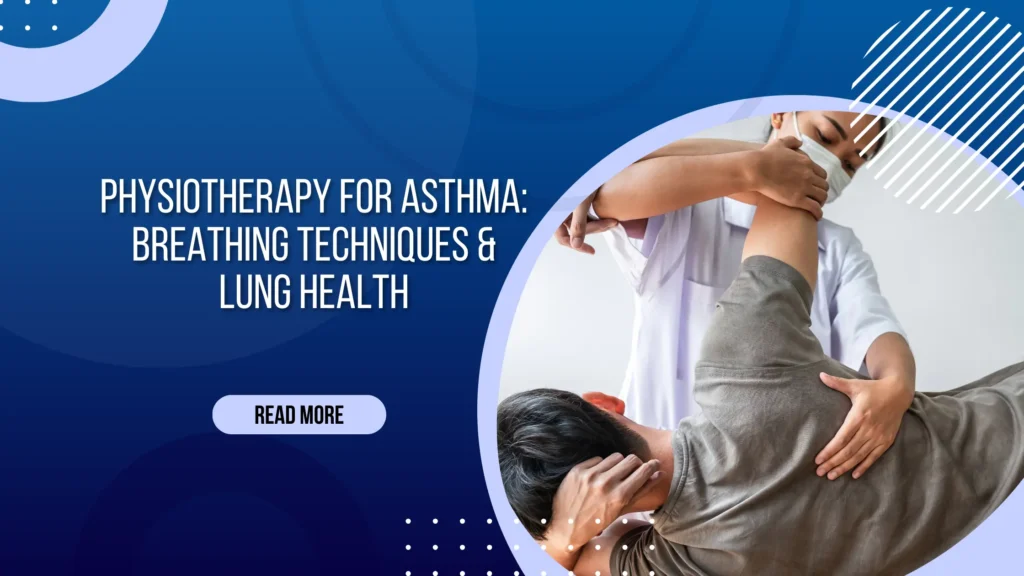Introduction: Breathe Easy with Physiotherapy for Asthma
Asthma can make every breath feel like a challenge, but managing it doesn’t always have to rely solely on medications. Physiotherapy offers a natural, effective approach to help control asthma symptoms, improve lung function, and enhance overall respiratory health.
How breathing techniques and chest physiotherapy can reduce asthma attacks.
Physiotherapy focuses on breathing techniques, chest physiotherapy, and posture correction to support better lung function. These methods help:
✔ Reduce the frequency and severity of asthma attacks
✔ Clear mucus buildup in the lungs, making breathing easier
✔ Strengthen respiratory muscles for improved lung capacity
✔ Enhance posture to allow for better airflow and lung expansion
Discover expert physiotherapy care at Vishudh Kaya Pain Relief & Multispeciality Clinic in Kharar.
At Vishudh Kaya Pain Relief & Multispeciality Clinic in Kharar, our team of skilled physiotherapists offers personalized treatment plans designed to help asthma patients breathe more easily and live more comfortably. Whether you’re dealing with mild or severe asthma, our holistic approach integrates to provide lasting relief. Take control of your asthma naturally with expert physiotherapy care. Book your consultation today and breathe easier with Vishudh Kaya!
● Understanding Asthma and Its Impact on Daily LifeAsthma is a chronic condition that affects millions of people worldwide. While it can vary in severity, one common challenge for all asthma patients is difficulty breathing due to airway inflammation and narrowing. Understanding how asthma affects the respiratory system, recognizing common triggers, and focusing on improving lung function can make a significant difference in managing the condition effectively.
What is Asthma, and How Does It Affect Breathing?

Asthma is a long-term inflammatory disease of the airways that causes breathing difficulties. When a person with asthma is exposed to a trigger or irritant, the following occurs:
● Inflammation: The inner lining of the airways becomes swollen and irritated, restricting airflow.
● Excess Mucus Production: The body produces thick mucus that clogs the air passages, making it harder to breathe.
● Bronchospasm (Airway Tightening): The muscles surrounding the airways tighten, further narrowing the bronchial tubes. These changes lead to classic asthma symptoms such as:
✔ Shortness of breath
✔ Wheezing (a whistling sound while breathing)
✔ Persistent cough (especially at night or early morning)
✔ Chest tightness and discomfort
Common Triggers and Why Managing Them Is Essential
Asthma symptoms are often triggered by specific environmental or lifestyle factors. Identifying and managing these triggers is essential to prevent asthma flare-ups.
Common Asthma Triggers:
✅ Allergens: Dust mites, pollen, mould, pet dander, and cockroach droppings can irritate the airways and cause asthma symptoms.
✅ Airborne Irritants: Cigarette smoke, strong odours, perfumes, and chemical fumes can trigger asthma attacks.
✅ Cold Air & Weather Changes: Sudden temperature drops, high humidity, or dry air can worsen asthma symptoms.
Exercise-induced asthma: Intense physical activity, especially in cold or dry conditions, can lead to shortness of breath.
✅ Respiratory Infections: Common colds, flu, and sinus infections can worsen asthma symptoms.
✅ Stress & Anxiety: Emotional stress can lead to irregular breathing patterns, making asthma symptoms worse.
By controlling exposure to these triggers, asthma patients can reduce the frequency and severity of attacks. Physiotherapy helps by training patients in breathing techniques that allow them to manage symptoms better, even when they cannot completely avoid triggers.
The Role of Lung Function in Controlling Asthma Symptoms
Lung function refers to how well the lungs can take in oxygen and remove carbon dioxide. In asthma patients, restricted airflow and inflammation impair lung function, leading to decreased oxygen levels in the blood and increased fatigue.
How Physiotherapy Helps in Asthma to Improve Lung Function

● Physiotherapy focuses on breathing exercises, chest physiotherapy, and posture correction to enhance lung efficiency. These techniques can:
✔ Strengthen respiratory muscles – Improves the strength and endurance of the diaphragm and intercostal muscles for better airflow.
✔ Increase lung capacity – Helps the lungs expand more efficiently, allowing better oxygen exchange.
✔ Reduce mucus buildup – Chest physiotherapy techniques help clear excess mucus, making breathing easier.
✔ Enhance oxygen circulation – Promotes better energy levels and overall respiratory health.
✔ Improve posture and rib cage mobility – Correcting posture ensures that the lungs have enough space to expand fully, allowing smoother breathing.
At Vishudh Kaya Pain Relief & Multispeciality Clinic, our team of physiotherapy experts uses a combination of breathing techniques, airway clearance therapy, and postural training to support asthma patients in improving their lung function naturally.
Can Physiotherapy Help Reduce Dependence on Asthma Medication?
Asthma is a long-term respiratory condition that affects millions of people globally. While medication remains the primary treatment, physiotherapy serves as an effective complementary approach to improving lung function, preventing flare-ups, and potentially reducing medication use. Here’s how physiotherapy can benefit asthma patients:
🔹 Breathing Techniques
Practising specific breathing exercises, such as diaphragmatic breathing and pursed-lip breathing, strengthens respiratory muscles, enhances lung capacity, and helps control breathlessness. These techniques also aid in better oxygen exchange and managing anxiety during asthma episodes.
🔹 Chest Physiotherapy
Asthma often leads to mucus accumulation, which can obstruct the airways. Techniques like percussion, vibration, and postural drainage help loosen and clear mucus, making breathing easier and reducing the risk of respiratory infections.
🔹 Postural Correction
Poor posture can limit lung expansion and disrupt breathing patterns. Physiotherapy emphasizes postural training and thoracic mobility exercises to improve lung function, enhance oxygen intake, and reduce respiratory strain.
Integrating physiotherapy into asthma care can lead to better symptom control, improved breathing efficiency, and a potential reduction in medication dependency. If you or someone you know struggles with asthma, consulting a physiotherapist may be a step toward better respiratory health.
How Physiotherapy Can Help Manage Asthma
Physiotherapy plays a crucial role in managing asthma by improving lung function, enhancing breathing techniques, and reducing the frequency of asthma attacks. Techniques such as breathing exercises, postural drainage, and airway clearance are commonly used to help patients breathe more efficiently and maintain better control over their symptoms.
For individuals with asthma, physiotherapy focuses on strengthening the respiratory muscles, increasing lung capacity, and promoting relaxation to prevent breathlessness. These techniques not only improve physical health but also boost confidence in managing daily activities without fear of triggering an attack.
Interestingly, the benefits of physiotherapy extend beyond respiratory conditions. For example, in cases of post-stroke recovery, physiotherapy is equally vital. Stroke survivors often face challenges with mobility, balance, and muscle strength. Physiotherapists use tailored exercises and rehabilitation programs to help patients regain independence and improve their quality of life. If you’d like to learn more about how physiotherapy aids in recovery after a stroke, check out our detailed guide on Physiotherapy for Post-Stroke Recovery.
By incorporating physiotherapy into your asthma management plan, you can experience significant improvements in your overall well-being. Whether it’s managing chronic respiratory conditions or recovering from a stroke, physiotherapy offers a holistic approach to healing and rehabilitation.
Effective Physiotherapy Techniques for Asthma Relief
Physiotherapy plays a vital role in managing asthma by improving lung function and reducing symptoms. Here are some proven techniques that can help:
🔹 Diaphragmatic Breathing – Focuses on deep breathing using the diaphragm, strengthening the lungs, reducing breathlessness, and making breathing more efficient.
🔹 Pursed-Lip Breathing – Helps control shortness of breath by slowing down exhalation, preventing airway collapse, and improving oxygen exchange.
🔹 Airway Clearance Techniques – Methods such as coughing exercises and deep breathing help remove excess mucus from the lungs, reducing airway obstruction and improving airflow.
🔹 Postural Drainage & Chest Percussion – Utilizes gravity and gentle tapping on the chest to loosen and clear mucus, promoting easier breathing and reducing the risk of infections.
Asthma is a long-term respiratory condition that causes difficulty in breathing due to airway inflammation. While medication plays a key role in managing symptoms, physiotherapy offers additional benefits by strengthening lung function, minimizing flare-ups, and improving overall respiratory health.
At Vishudh Kaya Pain Relief & Multispeciality Clinic, Kharar, we provide tailored physiotherapy programs designed to support individuals dealing with asthma.
Residents of Kharar and surrounding areas trust Vishudh Kaya Clinic for asthma management due to our integrated approach to physiotherapy. Here’s what sets us apart:
✔ Personalized one-on-one physiotherapy sessions that cater to individual needs.
✔ Advanced therapeutic techniques such as pulmonary rehabilitation, breathing exercises, and airway clearance methods.
✔ Expert care from skilled physiotherapists specializing in respiratory health.
Many asthma patients have noticed worsening symptoms after recovering from COVID-19, including persistent breathlessness and reduced lung function. Our specialized post-viral physiotherapy programs help:
✅ Restore lung capacity through structured breathing exercises.
✅ Strengthen respiratory muscles for improved oxygen intake.
✅ Minimize post-COVID complications with targeted rehabilitation techniques.
If you or someone you know is struggling with breathing issues post-COVID, physiotherapy can be a safe and effective way to regain respiratory strength.
Lifestyle Tips to Enhance Physiotherapy Benefits
Managing asthma effectively requires a holistic approach, combining physiotherapy with healthy daily habits. By making small but impactful lifestyle changes, you can boost lung health and maximize the benefits of physiotherapy.
Daily Habits for Better Lung Health
Incorporating simple routines into your day can improve breathing efficiency and reduce asthma flare-ups:
✔ Practice deep breathing exercises like diaphragmatic and pursed-lip breathing to strengthen your lungs.
✔ Stay hydrated to keep mucus thin and prevent airway blockages.
✔ Avoid allergens and irritants such as smoke, dust, and strong odours that can trigger asthma symptoms.
✔ Maintain indoor air quality by using air purifiers and ensuring proper ventilation.
The Role of Physical Activity & Posture Correction
Regular exercise and good posture play a crucial role in lung function:
✔ Engage in light physical activities like walking, yoga, or swimming to enhance respiratory strength.
✔ Focus on posture correction, as a straight back allows the lungs to expand fully, making breathing easier.
✔ Practice postural drainage techniques to help clear mucus from the lungs, reducing congestion.
Physiotherapy as a Long-Term Asthma Management Strategy
Physiotherapy isn’t just for short-term relief—it can be a powerful tool in long-term asthma management:
✔ Continued therapy sessions help in maintaining lung function and preventing complications.
✔ Learning self-management techniques ensure you can handle flare-ups independently.
✔ Combining physiotherapy with lifestyle adjustments offers sustainable and lasting asthma control.
By integrating these habits into your routine, you can enhance the effectiveness of physiotherapy and enjoy improved respiratory health.
Book Your Physiotherapy Session in Kharar Today!
If you’re looking for effective, non-invasive asthma management, Vishudh Kaya Pain Relief & Multispeciality Clinic in Kharar is your go-to destination. Our specialized physiotherapy programs help improve lung function, reduce breathlessness, and enhance overall respiratory health.
Why Choose Vishudh Kaya Clinic for Asthma Relief?
✔ Expert physiotherapists trained in respiratory care.
✔ Personalized therapy plans tailored to your asthma condition.
✔ Advanced techniques for long-term symptom control.
✔ Holistic approach combining physiotherapy, posture correction, and lifestyle guidance.
📅 How to Schedule an Appointment
Booking a session with our physiotherapy experts is quick and easy:
✅ Call our clinic to discuss your condition and schedule a consultation.
✅ Visit us in person for a detailed assessment.
✅ Get started with a customized physiotherapy plan for better breathing.
📞 Call us at: +91-76781 35151
📍 Visit us at: #8566, Sector 125, Sunny Enclave, Kharar, Mohali, Punjab 140301
🌐 Book online at: https://vishudhkaya.com
Take control of your asthma and breathe easier with professional physiotherapy at Vishudh Kaya Clinic. Book your session today! 🌿
FAQs About Stroke Recovery and Physiotherapy
How does a physiotherapist help with asthma?
A physiotherapist can help individuals with asthma by teaching breathing techniques, improving lung capacity, and reducing breathlessness. They may use exercises like diaphragmatic breathing, pursed-lip breathing, and airway clearance techniques to help manage symptoms and improve overall respiratory function.
Is chest physiotherapy used for asthma?
Yes, chest physiotherapy can be used for asthma, especially during flare-ups or when mucus buildup is a concern. Techniques like percussion, vibration, and postural drainage may be used to clear mucus from the airways, making it easier to breathe. However, these techniques are tailored to the individual’s condition and severity.
Can you go to physical therapy for asthma?
Absolutely! Physical therapy, particularly respiratory physiotherapy, can be highly beneficial for asthma patients. It focuses on improving breathing patterns, strengthening respiratory muscles, and enhancing overall lung function. It’s often recommended as part of a comprehensive asthma management plan.
Which therapy is best for asthma?
The best therapy for asthma depends on the individual’s symptoms and severity. Common therapies include:
Medication (e.g., inhalers, steroids) for immediate relief and long-term control.
Respiratory physiotherapy to improve breathing techniques and lung function.
Lifestyle modifications like avoiding triggers and staying active.
A combination of these approaches, tailored by a healthcare professional, often yields the best results.
Is physiotherapy good for the lungs?
Yes, physiotherapy is excellent for lung health. It helps improve lung capacity, clear mucus from the airways, and strengthen respiratory muscles. Techniques like breathing exercises, airway clearance, and aerobic conditioning can enhance overall lung function, making it easier to breathe and reducing the risk of respiratory complications.
Can physiotherapy reduce asthma attacks?
While physiotherapy cannot cure asthma, it can help reduce the frequency and severity of asthma attacks. By teaching proper breathing techniques, improving lung function, and promoting overall fitness, physiotherapy can help individuals better manage their symptoms and reduce triggers.


